There’s something magical about stepping into an orchard, the crisp scent of ripening fruit, the rustle of leaves in the breeze, and the sense of connection to nature that brings peace and joy. The phrase “Apple of My Eye” captures not just the sweetness of fruit but also the love and care that goes into tending an orchard.
Whether you dream of starting your own, already manage one, or simply enjoy seasonal apple picking, orchard life offers a blend of tradition, sustainability, and reward that is hard to match.
In this guide, we’ll explore the joys of orchard living, from the simple pleasures of harvest to the sustainable benefits and life lessons that orchards bring.
🌱 1. The Timeless Appeal of Orchards
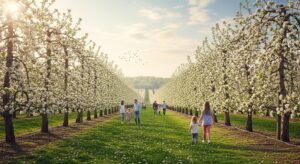
Orchards have always symbolized abundance, health, and family togetherness. Generations have gathered under apple, cherry, or pear trees to harvest fruit, share meals, and celebrate the seasons.
Unlike annual gardens, orchards are long-term commitments. Planting trees today ensures a harvest not only for you but for future generations.
Owning or working in an orchard cultivates patience, as trees often take years before producing their best fruit.
But when the first blossoms appear and fruit begins to ripen, the reward is sweeter than any store-bought alternative.
🍏 2. The Joy of Harvest Season

Few experiences compare to picking ripe fruit straight from the tree. In autumn, apple orchards come alive with baskets, ladders, and laughter as families gather to collect their bounty.
The joy isn’t just in the harvest itself but in the shared traditions of baking pies, pressing cider, or storing apples for the winter.
The harvest season also serves as a reminder of life’s cycles: hard work, patience, and care lead to fruitful rewards.
🌸 3. Orchards and the Rhythm of the Seasons

Orchard life is deeply tied to the natural rhythm of the seasons:
-
Spring: Blossoms attract pollinators and promise the year’s crop.
-
Summer: Trees grow vigorously, fruit begins to swell, and maintenance like watering and pruning ensures health.
-
Autumn: The harvest arrives in all its glory.
-
Winter: A season of rest, both for trees and orchard keepers, before the cycle begins again.
This seasonal rhythm fosters a closer connection to nature and reminds us of the importance of balance and renewal.
🐝 4. The Role of Pollinators
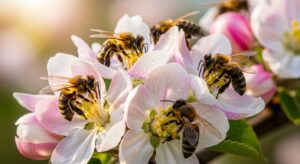
No orchard thrives without pollinators. Bees, butterflies, and other insects ensure fruit production by transferring pollen between blossoms.
For many orchard keepers, supporting pollinator populations is a top priority.
Planting wildflowers, reducing pesticides, and even hosting beehives in the orchard can ensure abundant harvests while also promoting biodiversity.
🛠️ 5. The Work Behind the Beauty
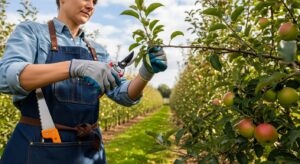
While orchards are idyllic, they also demand consistent care. Orchard management includes:
-
Pruning trees to shape growth and improve airflow.
-
Fertilizing and mulching to enrich the soil.
-
Managing pests and diseases through eco-friendly solutions.
-
Thinning fruit to prevent overloading branches.
This work is labor-intensive but deeply rewarding. Each task strengthens the bond between orchardist and tree, making the harvest feel like a shared victory.
🍎 6. Orchard-to-Table Living

One of the most fulfilling aspects of orchard life is enjoying food grown by your own hands. Fresh-picked apples, pears, or plums taste entirely different from supermarket produce. Homegrown fruit can be used in countless ways:
-
Fresh eating straight from the tree.
-
Pies, crumbles, and tarts are baked for family gatherings.
-
Freshly pressed apple cider or perry.
-
Preserves and jams for year-round enjoyment.
Orchard-to-table living promotes healthier diets and reduces reliance on commercial agriculture.
🌳 7. Orchards as Sustainable Ecosystems
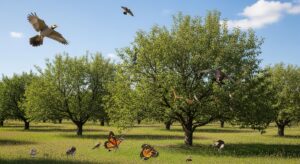
An orchard is more than a collection of trees—it’s a living ecosystem. When managed thoughtfully, orchards contribute to environmental sustainability:
-
Carbon Capture: Trees absorb carbon dioxide, helping reduce greenhouse gases.
-
Soil Health: Organic matter from leaves and pruned branches enriches the soil.
-
Biodiversity: Orchards support birds, insects, and small mammals.
-
Reduced Food Miles: Local orchards cut down on transportation emissions.
Sustainable orchards not only feed families but also heal the planet.
👩👩👧 8. Orchards as Family and Community Hubs
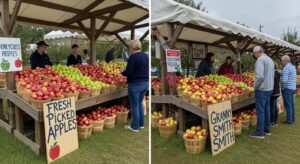
Orchards bring people together. Many communities host apple-picking festivals, cider tastings, or seasonal markets that revolve around orchard harvests.
Families also find joy in orchard activities, teaching children where food comes from, spending weekends outdoors, and creating lifelong memories.
For some, orchards even become family legacies, passed down through generations as living testaments to hard work and love of the land.
💭 9. Life Lessons from Orchard Keeping

Beyond the fruit, orchards teach us invaluable life lessons:
-
Patience: Trees need years to mature.
-
Resilience: Late frosts, pests, or storms can test a grower’s spirit.
-
Gratitude: Each harvest is a gift, never guaranteed.
-
Stewardship: Caring for land and trees ensures they thrive for the future.
These lessons make orchard life not just an agricultural pursuit but a spiritual practice of growth, care, and renewal.
🌟 Conclusion: Why Orchards Truly Are the “Apple of My Eye”
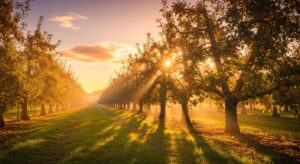
Living with or near an orchard is about much more than fruit; it’s about connection, tradition, and joy.
Orchards represent a bridge between humans and nature, reminding us that life is most rewarding when we nurture, wait, and celebrate the fruits of our labor.
Whether you plant a single apple tree in your backyard or dream of acres filled with blossoms, orchard life offers a timeless joy that makes the phrase “Apple of My Eye” ring true in every sense.
❓ 10 FAQs about Orchard Life
1. What is the best time to plant an orchard?
The best time to plant fruit trees is in early spring or late fall when the soil is cool and moist, allowing roots to establish before extreme temperatures.
2. How many years does it take for fruit trees to bear fruit?
Most apple and pear trees take 3–5 years, while cherries and peaches may produce earlier (2–3 years). Full harvests often come after 7–10 years.
3. How much land do I need to start an orchard?
You can start with just a few trees in a backyard or dedicate several acres for a commercial orchard. Even a small orchard with 5–10 trees can provide plenty of fruit for a family.
4. Do orchards require a lot of maintenance?
Yes, orchards need regular care, including pruning, watering, pest management, and soil enrichment. However, once established, they become less labor-intensive compared to annual gardens.
5. Can I grow an orchard organically?
Absolutely. Many orchardists use organic methods such as composting, mulching, and introducing beneficial insects instead of synthetic chemicals.
6. How important are bees in orchards?
Bees are essential for pollination, especially for apples and cherries. Without pollinators, trees produce fewer or no fruits. Some orchardists even keep beehives.
7. What’s the difference between a backyard orchard and a commercial orchard?
A backyard orchard focuses on family needs and enjoyment, while a commercial orchard is designed for large-scale harvest, often requiring more advanced equipment and business planning.
8. How do you protect orchards from frost damage?
Common methods include frost cloths, wind machines, heaters, or choosing frost-resistant tree varieties. Location and elevation also play key roles.
9. What are the health benefits of orchard life?
Aside from fresh, nutrient-rich fruit, orchard life promotes exercise, stress relief, and time outdoors while also encouraging healthier eating habits.
10. Can orchards increase property value?
Yes! A well-maintained orchard not only provides food but also adds beauty, shade, and long-term property value.